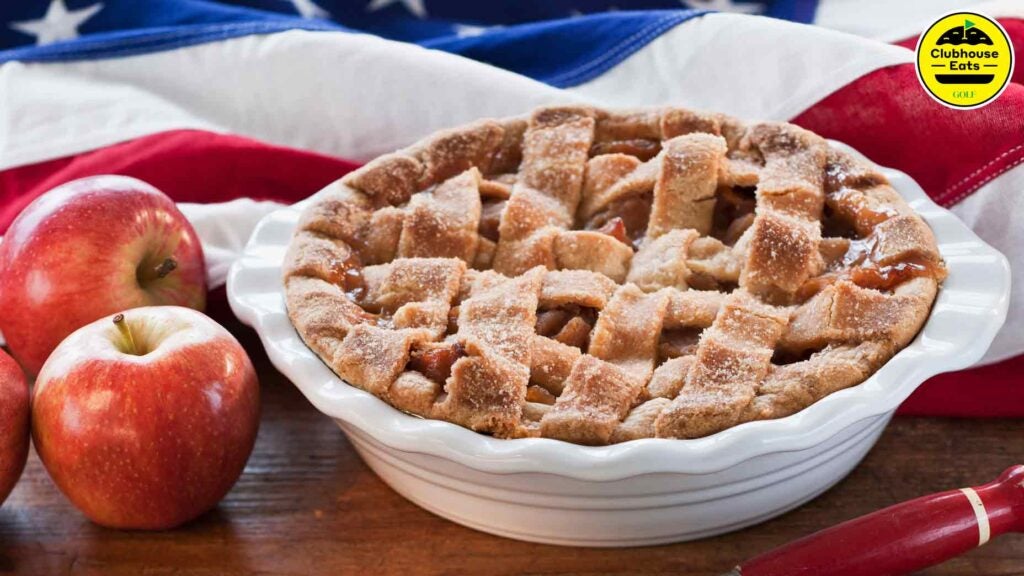Welcome to Clubhouse Eats, where we celebrate the game’s most delectable food and drink. Hope you brought your appetites.
***
The Fourth of July holiday is upon us, an occasion as American as …
You can see where this is headed.
Because every celebration deserves a great dessert, we turned to Judy Marts, pastry chef at The Dominion Country Club, in San Antonio, and asked her for tips on making apple pie.
How About Them Apples?
Not all varieties are created equal. Some have more desirable pie-making traits than others. While the Granny Smith is go-to for good reason, Marts is also big on Honey Crisp and Braeburn, both of which produce a balanced sweet-tart profile. What’s more, while baking, they release little liquid and hold their shape. On the flip side, Marts recommends against using Gala (they lose their shape); Fuji (they release too much liquid); and Red Delicious, which are too mild and break down too quickly.
To Peel or Not To Peel?
It’s not even question, Marts says. Always peel. In the best apple pies, the fruit and spices meld to create an enchanting filling. If you leave the peels on, those peels break down, coming shriveled, stringy or some unpleasant combination of the two.
Which Spice Is Nice?
Cinnamon is a must, Marts says. But nutmeg and lemon juice are also needed for balanced flavor. Marts suggests using about 1/4 teaspoon more of cinnamon than nutmeg. For a twist, you might also use cardamom, clove, allspice and/or ginger along with nutmeg and cinnamon. But use them sparingly. “You can always add,” Marts says. “But you cannot take away.”
Musts for Crusts
To get a flaky crust, you’ll need a fat. But which kind? While lard can yield a lovely, flaky crust, it has to be high quality lard, unhydrogenated and preservative-free. And that can be hard to find. Shortening works, too. It has a high melting point and is easy to mix in, so it’s got that going for it. Too bad “it lacks flavor” and gives the crust a greasy mouth-feel, Marts says. In her opinion, butter is best for both flakiness and flavor. The drawback is that it harder to work with because it has a lower melting point. When making a butter crust, keep all of the ingredients as chilled as possible. The rolling can be tricky if the butter is too cold, but be patient, Marts says. The extra work pays off.
A Lattice Top or Conventional Top?
Mostly, this comes down to personal preference. A lattice top is more time consuming, but the aesthetics are alluring, Marts says, as you can see the bubbly filling of spiced apples. But just because a conventional top is quicker doesn’t mean it can’t be top-notch, too. You can even dress it up by creating fancy edges. Whatever style you use, Marts says, be sure to brush with an egg wash, and sprinkle with raw or granulated sugar for a golden-brown crust with an appealing crunch.
The Ideal Thickness
How much filling to use is a matter of taste. But plan on using 2 1/2-3 pounds of apples per pie, Marts says. One pound of apples will yield about 3 cups of chopped apples.
Time, Temperature and other Tricks
For starters, bringing the heat, baking your pie for 15 in a 425-degree oven. Then reduce the temperature to 375 degrees and bake for another 35 to 40 minutes, until the piece is golden and bubbly. Bake on the lowest rack, with a large piece of aluminum foil underneath to catch drips. Marts recommends against a cookie sheet, as you want the heat to circulate and brown the bottom of the crust. Check the pie during the final 15 minutes of baking, and cover with foil if needed to prevent the top from getting overly browned. Let cool for 30 to 40 minutes. Then slice and eat.
